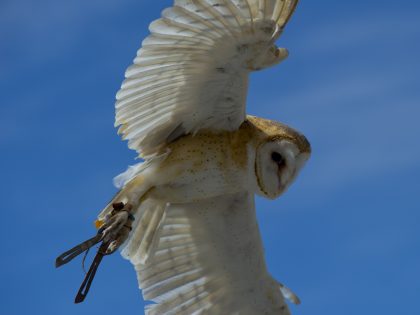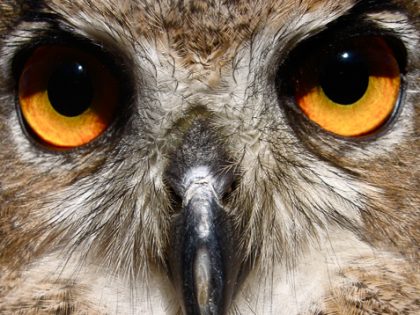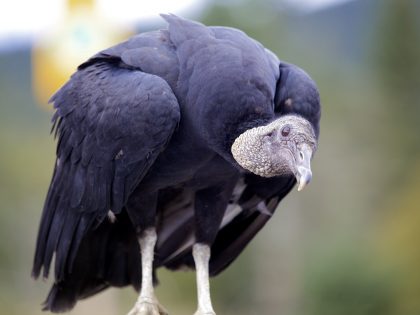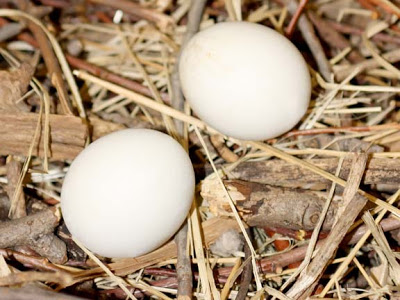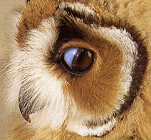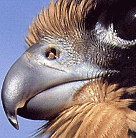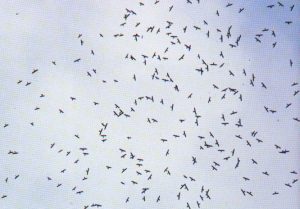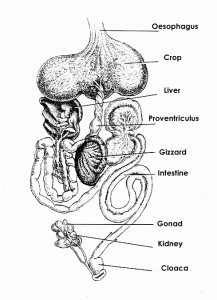FEATHERS
Feathers are without a doubt the most well known characteristic of birds. No other group of living animals has feathers. An incredible structure, the feather allows birds to fly, keep warm or cool down, can be used in courtship displays during breeding season, and are then essential for keeping eggs and young warm.
Barbs, the many tiny branches coming off the rachis (grooved tube-like structure at centre of the feather), create a feather surface (vanes) that stays together like Velcro, because of tiny hooks located on the barbules. Barbules, projections that join barbs together, each have little hooks that allow the barbs of the feather to hook up to one another.
The plumage of a bird is made up of various types of feathers:
Down feathers : This type of feather is small, fluffy and not at all rigid. Used for insulation, they keep a bird warm. Birds are covered with down feathers from birth.
Flight feathers : Long and rigid, they allow a bird to fly. Flight feathers are comprised of remiges (wing feathers) and rectrices (tail feathers).
Contour feathers : Covering a bird’s body, contour feathers give a bird its shape and help to insulate and are water-repellent.
Semiplumes : A mix between contour feathers and down feathers, they are situated beneath the contour feathers.
Filoplume : A thin feather, similar to a hair, it has a few barbs at its tip. Sensory corpuscles at their base help to monitor the flight feathers. Filoplumes are always found in association with flight feathers, semiplumes or down feathers.
Preening : Birds spend a part of their day preening. Using their beak, they comb the feathers and put in place the barbs and barbules of their plumage. During preening, they will also apply oil secreted by the uropygial gland located at the base of the tail to their feathers. This oil cleans and keeps feathers beautiful, impermeable (waterproof) and healthy.
Moulting: : Most birds of prey moult once a year, sequentially (one feather at a time), so that they are never in a position where they cannot fly. Four to eight weeks are needed to fully moult all plumage. The moult usually occurs at the end of the breeding season.
Feather weight : The Bald eagle (Haliaeetus leucocephalus) has more than 7000 feathers! Its plumage makes up 17 % of its weight, while its bones make up only 7 %.
Feathers on the feet : Most nocturnal birds of prey, owls, have feathers on their legs and feet. This dense plumage protects them against the cold and against the bites of rodents, which many of them eat.
FACIAL DISK
The beak, eyes and ear openings of nocturnal birds of prey are outlined with fine, rigid feathers called filoplumes, forming a facial disk. The facial disk acts like a satellite dish, channelling sounds towards the ears, allowing the bird to pinpoint the exact location of its prey, even if the prey is hiding under leaves. The facial disk of owls is comparable to our external ear.
Ear tufts : Ear tufts are feather groupings located on top of the head of several species of owls. Although they are called ear tufts and may look like ears, they are not; they are just feathers used for communication and camouflage. (These feathers can be moved to express the owl’s mood, much like a dog or cat’s hair can stand up to show fear or excitement).
Have you ever wondered why there are two words for owl in French: “hibou” and “chouette”? It is because in that language, there is a word for owls with ear tufts (les hiboux) and for those without ear-tufts (les chouettes).
Asymmetry : Owls have asymmetric ears. Having two ear holes of different sizes and placed at different heights on the head allows the owl to locate where a sound is coming from with great precision.
VISION
This diagram shows the eye structure of a typical raptor :

Birds of prey have very highly developed vision. Possessing more rods and cones than other vertebrates, provides them with advanced visual acuity and their retina is one and a half times thicker. The eyes of a raptor are very big. Taking up 2/3 of the space in their skull, they almost touch each other inside the skull.
Cones : Photoreceptor cells in the retina that perceive colours and permit the formation of precise images.
Rods : Visual receptors in the retina that are very sensitive to low light, they facilitate the detection of movements.
Retina : Photosensitive membrane of the eye where rods and cones are located.
Colour vision and night vision
Diurnal birds of prey can see more colours and can perceive objects about three times farther away than humans can. But their vision at night is weak.
It seems that nocturnal birds of prey cannot distinguish colours. Yet despite what people may think, owls see very well during the day. In fact the Great Horned Owl (Bubo virginianus) sees even better during the day than at night and it sees absolutely nothing in total darkness!
Owls possess a pupil (black circle at the centre of the eye) that they are able to dilate and contract by themselves (unlike humans whose pupils are controlled involuntarily). When an owl dilates its pupil in the darkness, it lets more light enter into the eye. This characteristic, along with the large number of rods in their eyes promotes a nocturnal vision in owls, which is three times better than ours.
Eye protection
Diurnal birds of prey, eagles and hawks particularly, possess a pronounced protruded brow bone that acts like a baseball cap, protecting their eyes from direct sunlight.
Falcons have black or dark moustaches under the eyes that absorb sunlight, thus preventing the glare of the sun from getting into their eyes. Football players use this same idea, which is why they paint black stripes under their eyes.
The nictitating membrane is a third transparent eyelid that sweeps the eye from the inside to the outside of the eye. This eyelid is quite transparent and allows light to pass through, it protects the eye, during flight and hunting they act like security goggles.
Field of vision : The raptor’s field of vision is very wide, and is especially concentrated in the front. Compared to other birds like pigeons, whose eyes are on the sides of the head, the eyes of birds of prey are situated in the front of the head. This provides them with a binocular vision that is well adapted for hunting.
Fixed eyes
The eyes of birds of prey are fixed to the inside of their sockets. Unlike us, they cannot move their eyes to the left and right, without moving their head. To counter this inconvenience, they have a particularly mobile vertebral column, possessing up to14 vertebrae. Humans have only 7 vertebrae. This unique feature is what permits birds of prey to rotate their heads 270 degrees or ¾ of a turn to each side. They cannot do a full turn as many people think.
BEAK
The shape of a bird’s beak is adapted to its diet. Birds of prey have a hooked beak, curved with very sharp edges. Their beak is not used to catch their prey but to cut through flesh and tear off meat.
The Falcon Tooth
Falcons possess a small projection on each side of their upper beak called a falcon tooth (tomial tooth) and a notch on the lower beak to make room for this “tooth”. Falcons use their teeth to quickly kill their prey, fitting them between the vertebrae and swiftly breaking the neck.
Central Bony Tubercle
How can a falcon breathe when diving at such fast speeds? Its nostrils have a small cone-like, bony central tubercle that deflects air. Slowing down the air entering the nostril, it helps reduce the pressure that could enter into the lungs when the bird is diving at high speeds. Modern jet engines are designed after this falcon feature. There’s a lot to learn from Nature!
The voice and calls of raptors
Birds of prey are not known for their delightful songs, seeing as how they cry or hoot (owls), to communicate. Some have an intense and piercing call, like the Peregrine Falcon (Falco peregrinus) and Red-tailed Hawk (Buteo jamaicensis). While others have funny calls, like the Bald Eagle (Haliaeetus leucocephalus), whose cry sounds like that of a seagull. Vultures, on the other hand, have no vocal cords and can only grunt.
Hooting
Owls are well known for their hooting. They will usually produce these sounds during the mating season. Males and females will hoot to communicate with one another. Certain owls, like the Great Horned Owl (Bubo virginianus), produce a typical hooting call (hoo hoo), while other species have a variety of different calls. The Eastern Screech Owl’s (Otus asio) call for instance, sounds like the neighing of a horse, and the Barn owl (Tyto alba) produces a scary shriek.
HEARING
The ears of birds of prey are just small holes on each side of the head. They are usually well hidden under the feathers of their heads, however they are visible on the naked heads of vultures and condors.
Sensitivity
Birds are sensitive to sound waves between 1 and 5 kHz. The limit is about 12 kHz. Humans can hear sound frequencies between 0.02 to 17 kHz.
The hearing of diurnal raptors
Diurnal raptors have hearing similar to humans. Since they are visual hunters, they do not require specialized hearing for hunting.
The hearing of nocturnal raptors
Unlike other birds, owls possess a very well developed sense of hearing, which is what allows certain species to catch their prey in total darkness. Several species are able to hear much higher and much lower frequencies than humans.
Facial disk
The beak, eyes and ear openings of nocturnal birds of prey are outlined with fine, rigid feathers called filoplumes, which form the facial disk. The facial disk acts like a satellite dish which channels sounds towards the ears, allowing the bird to pinpoint the exact location of its prey, even if the prey is hiding under leaves or snow. The facial disk of owls is comparable to our external ear.
Asymmetry
Owls have asymmetric ears. Having two ear holes of different sizes and placed at different heights on the head allows the owl to locate where a sound is coming from with great precision.
SMELL
REPRODUCTION
Usually, raptors nest in isolated couples and depend on a hunting territory that can range from 1 to over 300 square kilometres. The nest site is usually selected by the female and the nest is built by the two partners. Afterwards, the male hunts and provides food for the female which must be fit for laying, incubating and protecting the young.
The mating season
In North America, some raptor species start the mating season early enough in the spring when there might still be snow on the ground. Indeed, for certain large species, the time needed for selecting a partner, building a nest, incubating the eggs and raising the young can be significantly long. For these species, starting early and caring for the young long enough after they hatched is key. Since it can take over a year to raise one chick, certain eagle species commit 3 years to raising 2 young. Other smaller raptor species such as small falcons and hawks must handle a much shorter reproductive period of about 100 days in which they must select a mate, lay and incubate eggs and raise the young!
Nesters and non-nesting birds
Birds that find a mate and nest are called nesting birds or nesters, whereas other birds which do not are called non-nesting birds. Non-nesting birds are usually young adult birds, without their adult plumage, and are not ready to assume the role of a parent yet. It can also happen that adults that have not found a partner or a territory are considered non-nesting.
Forming a couple
In most raptors, males and females have very similar plumage. The most common way of distinguishing males and females in raptors is by size; the female being usually bigger than the male. Therefore, plumage colour does not play a role when selecting a mate (partner). Many diurnal raptors participate in “nuptial parades” where the male and the female fly close to each other, the male pretending to attack the female and the two gripping talons and performing aerial acrobatics. They can be seen flying one over the other, spiralling before they let go. Other parades show the male bowing to the female repetitively or bringing food to the female in an attempt to show-off his hunting abilities.
Raptors are usually monogamous, that is, they will stay with the same partner for at least a whole reproductive period. Bald Eagles and Barn Owls are thought to form couples over a longer period, sometimes for life. Couples usually part over winter and get back together in the same territory the year after. Certain species however, tend to be somewhat polygamous and a male can mate with several females or vice-versa. Northern Harrier males often have several mates which they must feed. It might happen however that an unhappy female will leave to find another male if the first is not attentive enough.
Cooperation
A few raptor species of are cooperative, this means that other non-nesting birds help a nesting couple in their tasks. In Harris Hawks for example, the young from the previous year often stay with their parents and help with feeding and protecting the current clutch (nesting young) which often allows the parents to produce a second clutch. The helpers gain experience and contribute to the reproductive success of their family. Couples of other types of falcons and hawks can also have help by unrelated helpers.
Many birds have a tendency to come back to nest at the same place that they were born. This also means that the areas used by certain species are well established. Large raptors usually nest in tall trees or on cliff ledges, and may use branches or leaves as nesting material. Once the nest is built, materials are added on year after year. If the couple does not come back the following year, the nest will probably be used by another couple of the same species or by a different animal. Some nests can grow to very large sizes; the record for the largest Bald Eagle nest is 8 square metres, representing 100 years of effort. Birds of prey also nest on the ground or in burrows, in tree hollows, in nest boxes, in abandoned nests, on buildings and other human structures like the pylons of high-tension wires.
The Osprey and certain types of falcons and kites are known to nest in colonies (groups of closely spaced nests) when prey is abundant and there is less reason for competition and aggression.
Mating
The act of mating permits the male to deposit his sperm into the female to fertilize her eggs and produce young. To do this, the male will attempt to hop on the female’s back. If she is receptive, she will lift her tail and lower her head, the male on top with then lower his tail in an effort to align his cloacae with hers and deposit his sperm. During the mating season, the couple will repeat this hundreds of times.
Eggs
Eggs exit from the female’s cloacae. They are laid one at a time, usually every other or 3rd day, and do not hatch at the same time. The number of eggs laid depends largely on the size of the species and the health of the mother, varying from 1 egg for a Condor, to 6 or more for smaller species. To encourage couples of endangered species to lay more eggs, scientists can get permits to collect the first batch of eggs to incubate them in a special incubator, and often the couple will lay another batch, or clutch. The eggs incubated in captivity will hatch and be released back into the wild once they are big enough.
Incubation
Once the first egg is laid, incubation begins; this is when the female (or male) will sit on the eggs to keep them warm with their body, helping the chick to develop. During incubation, the female is fed by the male and stays at the nest, turning the eggs from time to time to better distribute the heat. Nearing the end of development, the chicks can be heard peeping in the eggs. Hatching out of the egg can take 1 or 2 days to complete. The young bird will break the shell open using a special notch on its beak called an “egg tooth”. The egg tooth disappears quickly after hatching.
Parenting
Surprisingly, birds of prey are very attentive parents. During the mating season, the female will stay at the nest, incubating, feeding and protecting the young. The male must feed the female to ensure that she stays healthy. Sometimes they will exchange food in flight. When the male brings food to the nest, the female tears it into small pieces that she gives to the young. The male will continue to hunt for her and the young till all are ready to leave the nest. In vultures, tasks are shared more equally because they are scavengers.
When the young are ready to start flying, we call them fledglings. The parents will encourage the fledglings to fly towards them to get their meal. Soon the fledglings will be able to follow their parents and will learn to hunt for themselves. This learning period can last a few weeks for small species, or many months for larger ones like eagles and condors.
After hatching, a young raptor does not look much like its parent; it will be covered in white or grey downy feathers. The female will continue to keep it warm and shelter it from the sun, rain and snow. There may be an age difference of several days between the first laid young and the last; it is not uncommon for the youngest and smallest to die of hunger because it cannot compete with the bigger siblings, and sometimes the oldest will simply eat the youngest. Young birds grow rapidly, and depending on the species, may be ready the leave the nest 2 to 12 weeks after hatching once their flight feathers (rectrices and remiges) have grown in. At this point they will have also reached their full size.
MIGRATION
Some birds need to migrate because of fluctuations in their food sources. For instance, though a raptor found an abundance of prey in Canada over the summer, it may become scarce in the fall and winter months, this bird may have to migrate further south to where prey is more plentiful. Here in North America we can observe many important raptor migrations, such as the mass movement of Red-tailed Hawks (Buteo jamaicensis), Broad-winged Hawks (Buteo platypterus), Swainson Hawks (Buteo swainsoni) and Sharp-shinned Hawks (Accipiter striatus).
To migrate, raptors use rising currents of hot air called thermals, as well as wind currents that deflect off mountains and cliffs. For the most part, all they have to do is open their wings and let themselves be carried away. This allows them to save a great deal of energy, as flapping their wings is very demanding. As it follows its migration route, a bird soars from one thermal to another. Concentrations of migrating raptors can be seen in places where there is an abundance of thermals. During fall migration, thousands of raptors can be seen all in one day at specific sites, like Hawk Mountain, Pennsylvania.
INTERNAL ANATOMY
AIR SACS AND HOLLOW BONES
A human’s bones are filled with marrow, but many of the large bones in birds are hollow and have air sacs within them. Attached to the lungs, the air sacs fill with air with each breath. It is safe to say that having these air sacs can help them be lighter for flight.
Weight
Birds have many adaptations for flight. This makes it hard to estimate their weight, since a large bird is still quite light. For instance, a Bald Eagle weighs between 7 to 12 pounds, or around 10 kilograms, and a small raptor like the Saw-whet owl weighs about a quarter of a pound or 100 grams.
The Division of Weight
In general, the skeleton of a bird weighs less than all its feathers. Though feathers are light, they can account for up to 20% of a bird’s weight. Muscles represent about half the weight of a raptor, or 50%. Let’s not forget that after a meal, a raptor must carry the extra weight; the prey can then account for 40% of its weight.
Females vs. Males
Unlike other birds, there are few species in birds of prey where males and females can be distinguished by the colour of their feathers. There does exist an easy way to tell them apart though, size! The female is most often heavier and bigger than the male. In falcons especially, the male can be one third smaller so he is often referred to as the tiercel. Scientists have many ideas to explain this size difference, for example the larger females can better defend the nest and nestlings and can hunt larger prey than the male.
THE DIGESTIVE SYSTEM
The digestive system of birds is similar to that of humans but with a few different adaptations. Here are the key parts:
Crop : Pouch-like enlargement of the oesophagus. The crop is where food is stored for a certain amount of time before it is passed into the stomach. Food is also regurgitated from the crop. The crop is absent in owls, so they store their food in the oesophagus.
Proventriculus (or glandular stomach) : This first section of the stomach is lined with digestive glands that secrete enzymes to digest food.
Gizzard : The second part of the stomach is muscular. The thick muscles grind and crush food, just like the molars of an animal with teeth. It is most developed in birds that eat seeds, as these need to be well ground.
Cloaca: The cloaca is the cavity where the urinary, intestinal and genital tracts empty. It is here that the urea (avian urine) and digestive excrements mix to form the bird’s feces, which will eventually be expelled out of the bird’s anus or vent.
Boulettes de régurgitation
While diurnal raptors generally tear up their food before swallowing it, owls usually swallow their prey whole. Luckily, the enzymes of the proventriculus (glandular stomach) can dissolve most of a prey’s tissue and small bones, but not the fur or feathers. All non-digested food is trapped in the gizzard, forming a pellet (ball) that the raptor will eventually regurgitate (cough up). The bird’s digestive system usually takes about one day to transform a prey into a pellet. Raptors generally produce one pellet per meal. Since owl stomachs are less acidic than those of diurnal raptors like hawks or falcons, they produce pellets with more bones and more complete skeletons. Using the bones of the skeleton and diagrams it can be easy to identify the animals they ate.
SKELETON
The skeleton of a bird is totally adapted for flight. Many of their bones are fused together, and they have a pronounced keel where the pectoral muscles, that are responsible for wing movement, are attached. Note the large eye sockets, where the raptor’s huge eyes are located. In diurnal birds of prey, the protruding brow is also part of the skull.

